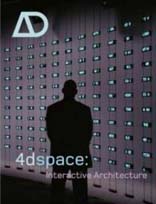
Architectural Design, vol 75, 1, Jan/Feb 2005, pp. 23-29. Special
Issue 4dspace: Interactive Architecture, editor Lucy Bullivant.
|
|
Interactivity is now the catalyzing element of architectural research
and development activity because it is within this that the contemporary
communication system, based on the possibility of creating metaphors
and so of firstly navigating and then building hypertextual systems,
resides.
Secondly,
interactivity places at its centre the subject (variability, reconfigurability,
personalisation) instead of the absolute nature of the object (serialization,
standardization, duplication). Thirdly, interactivity incorporates
the fundamental feature of computer systems, namely the possibility
of creating interconnected, changeable models of information that
can be constantly reconfigured. And lastly, interactivity plays, in
structural terms, with time, and indicates an idea of continuous ‘spatial
reconfiguration' that changes the borders of both time and space that
until now have been consolidated.
HYPERTEXTS
AND THE CREATION OF METAPHORS: INTERACTIVITY WITHIN THE WORLD OF COMMUNICATIONS.
Many of us will still remember the ways in which architecture used
to be taught us. For a long time, the key word was objectivity. We
had always to demonstrate analytically the relationship between a
cause and a specific solution; good architecture sprang from this
association. However, this way of thinking has now gone out of fashion,
together with the great industrial model. Today, narration holds pride
of place. Consequently, what comes first is the story to be told,
and it is only after and within this narrative that the project develops.
There are examples of this in front of us all.

Peter Cook and Colin Fournier, Kunsthouse Graz, 2003. The
interactive facade is by Realities United.
We
must also add a second factor to this narrative component, and it
is here that interactivity comes into play. More and more, contemporary
communication is also metaphorical. Metaphor replaces a unidirectional
cause–effect reasoning with pluridimensionality and the discontinuity
of rhetorical figures. Instead of in a linear manner, advances are
made by hops and jumps.
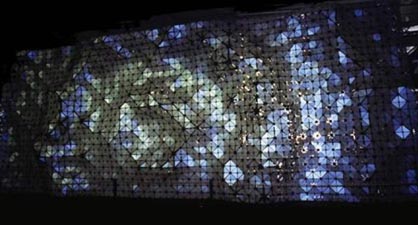
dECOi, aegis hypo-surface, Birmingham, 2002. Photo: Mark
Burry.
But
is not hypertext the communicative setting of these jumps? With HTML(hypertext
mark-up language), its links and the Internet, is hypertext not an
inalienable part of our way of thinking today? The most fitting definition
of hypertextual systems is that of being themselves settings in which
metaphors are created. The challenge in this sector lies not only
in creating predefined metaphors (for example, an artist's production
exhibited in his virtual studio), but also that of being able to have
‘mobile metaphors' that can be reconfigured each time by the
user. An ever-growing number of systems are able to create actual
metaphors that can be personalized (consider, for example, the creation
of scenarios that can be played or visited through the use of artificial
intelligence techniques, or searches in databases that can be personalized,
or virtual simulations). By this we mean that interactivity thrusts
the sphere of contemporary communication towards a more complex level:
metaphors and images that are already defined begin to be replaced
with the idea that we can ourselves create our own metaphors. This
is the great challenge of the world of hypertextual communication.
It is an open battle, one that is also political and social, and that
implicates the development of an increasingly mature critical sense.
When I teach, from the outset I ask all my students to create and
publish their own web pages: this is no coincidence.
INTERACTIVITY AND THE COMPUTER WORLD. Information technology is the
underlying ‘mental landscape' of today's architecture. By mental
landscape I mean that architectural research (since the outset) prefigures
the ideal context in which it is located. Architecture prefigures
this mental landscape by supporting some elements already present
in reality, developing other elements and, above all, incorporating
scientific or symbolic models that have succeeded each other over
time. That is, architecture transforms these models into specific
spatial interpretations.
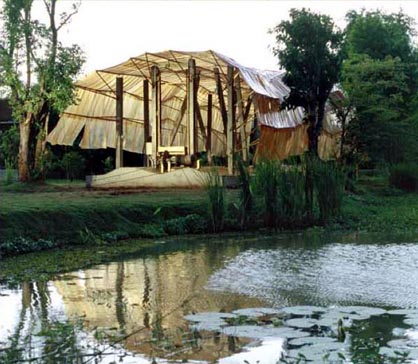
Philippe Parreno, François Roche, Hybrid Muscle, Work
and Exhibit space self generator of energy, Chang Mai, Thailand, 2003.
INTERACTIVITY
AND TIME. Now we come to the last set of considerations, which is
in some sense the most complex. Interactivity is associated with time,
which as Einstein himself wrote, is the only way to say something
sensible about space. Let us recall some fundamental concepts. In
the first place, space is not an objective reality (as we often believe),
but is perceived culturally, historically and scientifically in very
different ways. If we use time as a system for understanding space,
we discover something that is highly effective. The jump rule prevails
from one reference system to the other; it is the same jump that underlies
hypertextual systems. (If I live in and know only a two-dimensional
system – imagine a curved sheet of paper – in order to
go from one point to another, I follow a route equal to T. Even if
I curve the surface greatly, T still remains the same length. But
if I look at this curved sheet from a three-dimensional world, I immediately
note that A and B can be linked not only by segment T, but also by
a far shorter spatial vector, ‘t', which travels, or rather
jumps, through three-dimensional space).
Interactivity
in buildings can mean not only varying configurations and spaces according
to changes in wishes or external input (as we have just seen), but
also creating different systems of spatio-temporal reference.
|
|
|
|
|
|
If
an interactive system modifying architecture is linked to Internet-based
navigational systems, the effect of the jump can pervade the whole
of architecture: a jump from one spatial configuration to another,
a jump between different information systems and, finally, a jump
between different temporal states. Associated with window interface
systems, real-time navigation systems, remote depiction systems with
naturally interactive, hologram-based systems (a brief step forward
that will shortly be made), the great world of Internet can form an
incredible ‘thickener' and multiplier of spaces and times. We
can have windows open at the same time on worlds far distant from
each other, and literally jump from one to the other: live in them,
try out accelerating or moving spaces, show and be shown, and all
this in real time and in a continuous jump from one world to the other.
The Internet is a necessary instrument for architecture in this stage
of research, not only because of its pragmatic aspects, but also for
its cognitive ones. As we learn more, we understand how a fundamental
formulation takes effect through Internet and interactivity: from
a lower system, we can have the projection of a higher level. This
formulation means that it is possible, although physically located
within fixed three-dimensional spatio-temporal limits, to have ideas
about a space with more dimensions than our own, and to use, imagine
and, to some extent, understand it; even to design this multidimensional
space.
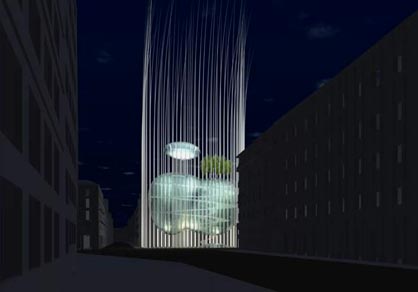

Makoto Sei Watanabe, Fiber Tower, Milan, 2004.
At
this point, I hope that it is now clear how three key questions can
be traversed by the concept of interactivity. First of all, through
the relationship with the world of contemporary communication and
a greater subjectivity of choices (and both these components have
an obvious implication with regard to the critical and political development
of singularity). Moreover, interactivity is a central factor in the
mental landscape of the new architectural research (through the absorption
of the dynamic models of information technology). Finally, interactivity
makes it possible to start to design and imagine spaces and architecture
that develop in not just three dimensions but which project upon themselves
the possibility of further dimensions through the process of jumping
and discontinuity.
|
|
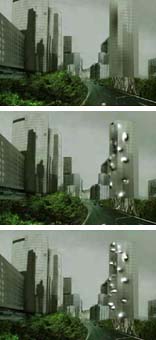
R&Sie..., Un Plug, reactive office building à
la Defense, Paris.
|

Diller+Scofidio, Cloud, Swiss Expo 2002.
|
|
The interactivity incorporated within the physical nature of buildings
means working at a new level of architectural complexity. But the
greatest challenge of all is not scientific (creating increasingly
mature mathematical models), nor technological (creating the physical
and electronic systems to enable levels of interactivity and sensibility
in buildings and settings). And neither is it even functional (understanding
how to make interactivity an element of research in the ‘crises'
and difficulties of contemporary society, rather than just a game
in the homes of the super rich). No, the true challenge is, as always,
of an aesthetic nature. Searching for an aesthetic (that is, a way
of seeing, interpreting and building the world of architecture) that
is deeply and necessarily interactive. It is here that the role of
the catalyst comes back into the picture.
Interactivity
is the chemical reagent, the catalyst of all these components. It
has, simultaneously, an ethical component and a political one, a technical
and a technological one, and it also has a fundamental aesthetic component
because it requires a revolution in sensing that pushes for a new
awareness of contemporariness.

Chaos Computer Club, Haus des Lehrers, Berlin, 2002.
Looking in an extremely summary manner at the change in the picture
of contemporary architecture, we can say that if the formula for the
Modern Movement was rightly Neue Sachlichkeit (New objectivity), the
formula for today cannot be other than New Subjectivity. And it is
interactivity that is the key to this new subjectivity. Transparency
used to be the aesthetic, and ethics the reason and technique of a
world that wanted rationally to tackle an advance in civilization
in terms of quality of life for the great masses of industrial workers.
Today, by contrast, interactivity constitutes a point of aggregation
for present-day considerations about an architecture that, having
gone beyond the objectivity of needs, can now tackle within its own
modifications the subjectivity of the desires of today's men and women.
Antonino Saggio
|
|
|








